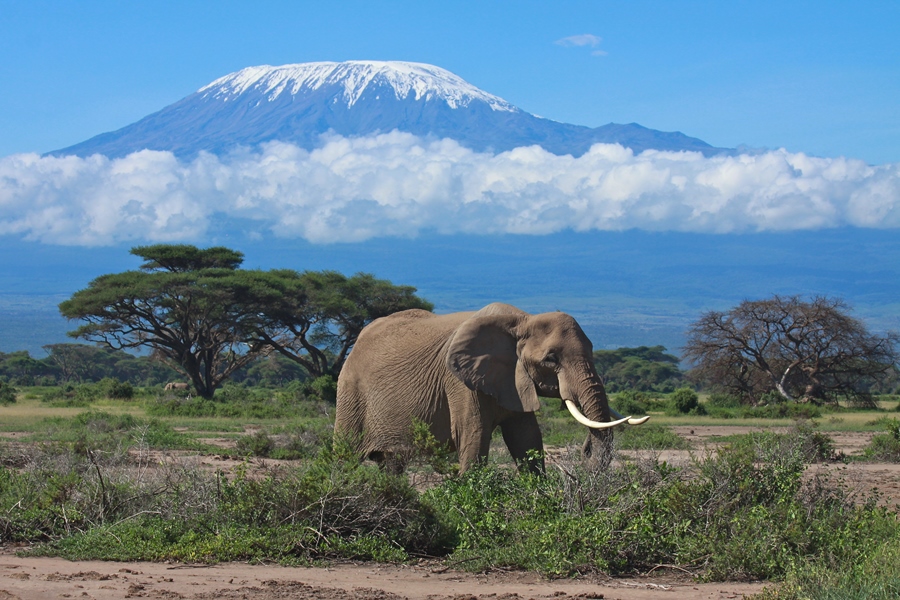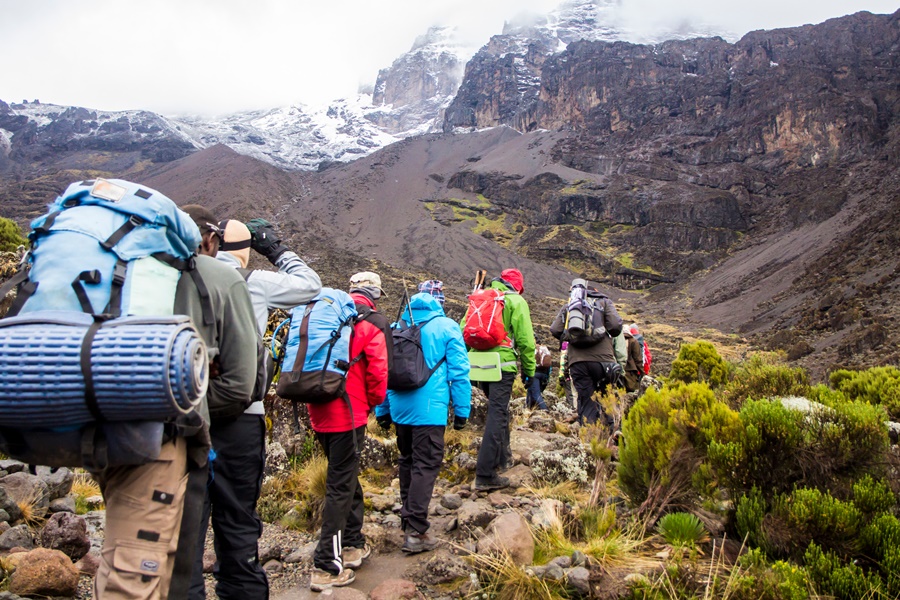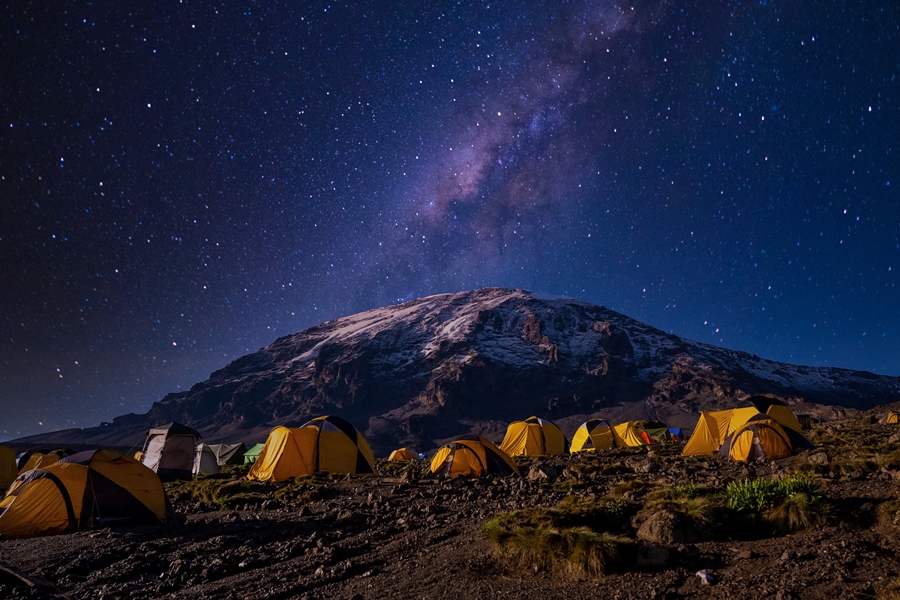
Very few experiences can compete with standing at the top of the world’s tallest mountains, gazing down at terra firma kilometres below you. Needless to say, climbing Mt Kenya or Kilimanjaro is on many people’s bucket lists when visiting Africa.
If you want to compare Mount Kenya vs Kilimanjaro, you’ve come to the right place. We break down things like budgets, fitness and trekking durations, plus answer questions like how tall is Mt Kenya, when is the best time to climb Mt Kilimanjaro, and more.
Quick Overview
| Mount Kenya | Mount Kilimanjaro | ||||
|---|---|---|---|---|---|
| Location | Kenya | Tanzania | |||
| Nearest Airport | Nairobi | Arusha | |||
| Height | 5,199 metres (17,057 feet) | 5,895 metres (19,340 feet) | |||
| Official Trekking Routes | 7 | 6 | |||
| Most Popular Routes | Chogoria Naro Moru Sirimon |
Machame Rongai Lemosho |
|||
| Average Duration of Trek | 5-6 days | 6-8 days | |||
| Accommodation | Mainly camping in tents. Some routes have huts or cabins. |
Camping in tents. Marangu route has huts. |
|||
| Technical Climbing Equipment | Not needed to hike Point Lenana. Proper rock-climbing equipment needed for Batian and Nelion peaks. |
Not needed. | |||
| Difficulty & Technicality | Point Lenana is not difficult and a manageable trek. Batian and Nelion are only recommended for experienced mountaineers and rock climbers. |
Not difficult and walkable for the most part. | |||
| Best Time to Go | January–March June–October |
December–March June–October |
Mount Kenya

The tallest of all Kenya mountains, Mount Kenya rises just over 3,800 metres (17,000 feet) and is the second highest mountain in Africa. The massif comprises three main peaks: Batian, Nelion and Point Lenana. Batian and Nelion are the highest peaks and require advanced rock climbing and mountaineering skills to conquer. It’s about 4,985 metres (16,355 feet) to Point Lenana’s summit, which can be reached by walking.
There are eight main hiking routes up Mt Kenya:
- Meru
- Chogoria
- Kamweti
- Naro Moru
- Burguret
- Sirimon
- Timau
- Peak Circuit Path
Most hikers go up and down a combination of three routes – Naro Moru, Sirimon and Chogoria – which generally take about five to six days to complete. These three routes also feature staffed gates which make them the most frequently used, while the other routes require special permission from the Kenya Wildlife Service to hike.
The most popular rock-climbing routes on Mt Kenya are:
- Batian
- Nelion
- Point Pigott
- Thomson’s Flake
- Point Dutton
- Point John
- Point Melhuish
- Point Peter
- Midget Peak
These technical rock-climbing routes range from 4,700 metres or 15,420 feet (Midget Peak) to Batian’s towering 5,199 metres (17,057 feet).
Most of the routes up Mt Kenya require camping in tents, however, there are exceptions like Chogoria, Naro Moru, Sirimon, the Peak Circuit Path and Nelion that feature huts. These can range from very basic structures with little more than a tin roof, to cabins with log fires and running water.
Mount Kenya is a UNESCO World Heritage Site and most of it is protected by Mount Kenya National Park. It offers hikers breath-taking mountain scenery of glaciers, lakes, mineral springs, and alpine forests to trek through, as well as spotting some wildlife. Compared to Kilimanjaro, Mount Kenya is considered a more scenic trek.
Even though Mt Kenya is relatively simple to reach – located about 160 kilometres (100 miles) north of Nairobi – it doesn’t see the large visitor numbers the more popular Kilimanjaro is used to. This makes climbing Mt Kenya vs Mt Kilimanjaro a more tranquil and less expensive trekking experience.
Mount Kilimanjaro

Rising nearly six vertical kilometres (4 miles) from the surrounding plains of northern Tanzania, Mount Kilimanjaro a.k.a. Kili is not only the highest mountain in Africa but it’s also the biggest free-standing mountain on the planet. It’s one of the Seven Summits (the highest mountains on each of the traditional continents), making it a major hiking destination and a bucket-list experience for most intrepid travellers.
Located about an hour’s transfer from Arusha Airport, Mount Kilimanjaro comprises three volcanic cones: Kibo, Mawenzi and Shira. Kibo is the tallest of the three and home to Uhuru peak, Kili’s highest.
There are six official hiking routes up Kilimanjaro:
- Machame – good for travellers who want a typical Kili trek
- Marangu – a scenic route that’s ideal for those with a reluctance to camping in tents
- Rongai – one of the quieter routes on the mountain
- Lemosho – a long route with fantastic scenery and a very good success rate for summiting
- Shira – nearly identical to Lemosho; Shira was the original route and Lemosho is considered the improved variation
- Umbwe – a difficult route, but the quietest on the mountain
All the routes up Mount Kilimanjaro require camping in tents except Marangu, which is the only route on the mountain that offers huts for hikers.
As you ascend Mount Kilimanjaro, you’ll hike through various vegetation territories. The adventure starts in emerald forest inhabited by antelope, primates, buffalo and leopard, followed by a moorland covered with heather and studded with giant lobelias. Next, a surreal alpine forest gives way to an Arctic-like wonderland of ice and snow. You’ve reached the roof of Africa!
The mountain forms part of Kilimanjaro National Park and sees about 20,000 visitors per year hike up its slopes. Compared to Mt Kenya, Kili’s hiking routes are busier, especially during the dry seasons of January to March and June to October.
Trekking Mount Kilimanjaro does not require any technical climbing skills – all the trails are walking routes only. That said, hiking up the mountain is no stroll (it can take between six to eight days to complete an entire trek), and a reasonable level of fitness is required.
Frequently Asked Questions

1. When is the best time to climb Mt Kenya?
Although the mountain can be trekked year-round, the best time to climb Mount Kenya is during the dry seasons of January to March and June to October.
2. When is the best time to climb Mt Kilimanjaro?
The best time to climb Mount Kilimanjaro is when the weather is warm and clear – the views are most impressive and the conditions are not too hazardous for camping on the mountain. This is usually from December to March, and June to October.
3. How fit do I need to be to trek Kilimanjaro and Mount Kenya?
Even though all the hiking trails on Kilimanjaro and Mount Kenya are walking routes only – except Batian and Nelion on Mount Kenya – a reasonable level of fitness is required. Although there is no need to go overboard with your fitness preparation for climbing the mountains, the fitter you are, the more enjoyable your trek will be.
The best preparation for trekking up Kilimanjaro and Mount Kenya is taking long walks at home – or better yet, going on a few hiking trips. Include some uphill sections and wear the clothes – especially boots and socks – that you’ll be wearing on the mountain. Although taking regular walks at home won’t make you very fit, it should make your body used to walking a few hours at a time, for about five or six days in a row.
But the biggest part of the challenge is mental. It is absolutely vital to prepare your mind for the expedition. While altitude sickness is the number one reason why most people fail to make it up Kilimanjaro and Mount Kenya, a lack of determination is a close second. It’s cold up there, the weather can change very quickly, and when altitude sickness starts kicking in from about 2,500 metres (8,200 feet), you may at times feel awful. This is when you need to dig deep and remind yourself why you are climbing Africa’s highest mountains!

4. Which health and safety tips are there for climbing Kilimanjaro and Mount Kenya?
At Go2Africa, we only book treks with reputable companies that employ guides who are all licensed and have received training from the appropriate park authorities in high-altitude health and altitude sickness. This is important for your absolute peace of mind.
Each hiking expedition must be equipped with a comprehensive first-aid medical kit and oxygen for hikers who may suffer from altitude sickness – although it’s an absolute last resort and your guides should be trained to monitor the behaviour and physiology of each climber in order to spot altitude sickness before it becomes necessary for oxygen.
Altitude sickness occurs when your body finds it difficult to adjust to low oxygen levels at altitudes from about 2,500 metres (8,200 feet). Breathing becomes more difficult when the amount of oxygen available decreases as the altitude increases. Acute mountain sickness (AMS) is the mildest form of altitude sickness, and very common. The symptoms will usually feel like a hangover: dizziness, headache, muscle aches, nausea, and loss of appetite.
Altitude sickness usually settles by itself within six to 48 hours. The main treatment involves going down to a lower altitude as safely as possible. Depending on the severity of your symptoms, your guide may decide to send you back down the slopes to guarantee your safety. This usually involves returning to your previous campsite, before deciding on a suitable rendezvous with your fellow hikers further up the mountain.
Although it is possible to ascend and descend Mount Kilimanjaro in five days, the recommended minimum duration for a trek is six days. This should give hikers sufficient time to acclimatise properly to high altitudes, delivering the best success rate for summiting.
Even the fittest hiker benefits from an anti-altitude sickness medication’s ability to make your blood absorb more oxygen, so chat with your GP about a prescription before your trek. Just remember, anti-altitude sickness medications are often diuretics. Dehydration is a major contributor to altitude sickness, so make sure that you always have enough drinking water with you on the mountain.
Many mountain climbers combine a Kilimanjaro or Mount Kenya trek with a week on safari for some much-needed R&R. Even a grand finale on Zanzibar or Kenya’s fine beaches are popular add-ons – get in touch with our Africa Safari Experts to help tailor-make a trip that’s right for you.

5. What does it cost to trek Mount Kenya vs Kilimanjaro?
The price of a guided trip up Kilimanjaro and Mount Kenya depends on factors like the time of year you wish to trek, the number of people in your booking group, the duration of your trek, and the calibre of your trekking operator. A general cost guideline is:
- Mount Kilimanjaro – between USD 2,000 and USD 6,000 per person
- Mount Kenya – between USD 2,000 and USD 4,000 per person
Prices usually include:
- Road transfers to and from the mountains
- Park fees, camping fees, rescue fees, and permits while on the mountain
- Camping equipment
- Meals and drinks
- Wages for trekking crews (guides, cooks and porters)
6. What should I pack for a Mount Kenya and Kilimanjaro trek?
When you book with a reputable trekking operator, your tent, sleeping mat, cooking equipment, cutlery and crockery are usually provided for you. You will still need to pack items like:
- Very warm sleeping bag
- Water bottles or hydration pack systems
- Water purifiers or filters
- Head-torch
- Sunscreen
- Towel
- Sunglasses
- Anti-altitude sickness medication
- Essential toiletries
- Bandanna or buff
- Chapstick
Essential hiking equipment for Mount Kenya and Kilimanjaro include:
- Comfortable, sturdy, waterproof, and durable hiking boots that are high enough to support your ankles
- Socks – a couple of thick thermal pairs and some regular ones
- Fleeces
- Down jacket
- Thermals
- Sun hat
- Woollen or fleece hat (beanie)
Recommended technical climbing gear for the Nelion and Batian peaks on Mount Kenya:
- Climbing ropes and harness
- Helmet
- Rock shoes
- Belay or rappel plate
- Karabiners
- Slings
- Prussic loops
- Nuts or wires
- Cams
- Quickdraws or extenders
- B1 boots, crampons and an ice axe may be required for snow or ice conditions

AUTHOR: Louis Nel
SOURCE: go2africa.com
PHOTOCREDIT: go2africa.com












